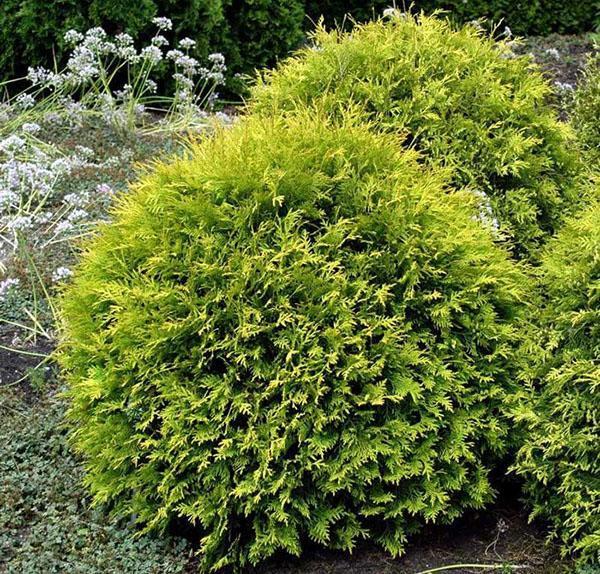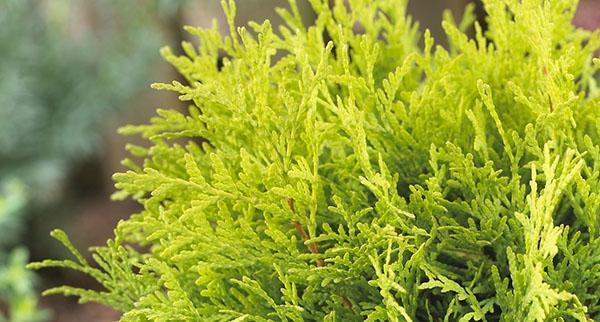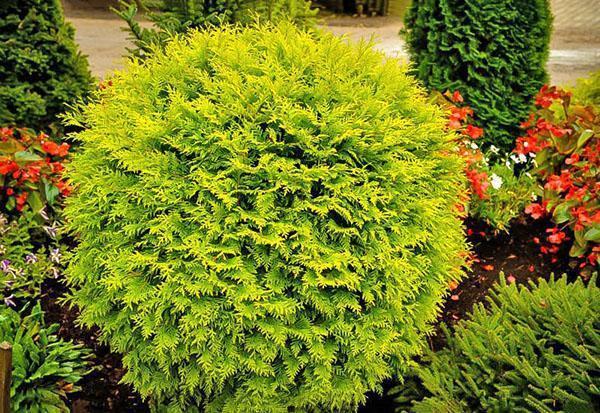Choosing a place in landscape design for thuja Golden Glob
 Golden needles, compact spherical crown and extreme simplicity. Thanks to these qualities, thuja Golden Globe invariably enjoys the attention of coniferous plant lovers and professional landscape designers.
Golden needles, compact spherical crown and extreme simplicity. Thanks to these qualities, thuja Golden Globe invariably enjoys the attention of coniferous plant lovers and professional landscape designers.
Small evergreen shrubs with bright needles of an unusual shade find a place both in summer cottages, and on city streets, and in containers for landscaping terraces, roofs, balconies, residential and public interiors.
Description of Tui Golden Globe

The strengths of the variety include:
- decorativeness that persists throughout the year;
- the original shape of the crown, which does not change over time;
- yellow needles at the ends of the branches;
- small, up to 5-10 cm per year, growth rates;
- high frost resistance, making it accessible to summer residents of both the middle lane and regions to the north;
- easy care;
- good survival rate after planting.
As follows from the description of thuja Golden Globe, the characteristic yellowness of the surface scaly needles in autumn is replaced by brownish-red shades of copper.
In the spring, when the growing season begins, the plant regains its unique color. However, the summer resident will be able to rejoice at the living golden balls on the site only with the correct planting of the bush.
Thuja is photophilous, and this, first of all, refers to varieties with a yellow crown. Falling into the shade, such plants soon lose their original shade, becoming light green. Crohn loses its density and natural spherical shape. Therefore, a place for planting a bright ephedra is chosen in the sun or in partial shade, but always with protection from the cold wind.
 The maximum possible sizes for a variety spherical thuja Golden Globe reaches only 15–20 years old. The width of its crown reaches 100–120 cm at the same height.
The maximum possible sizes for a variety spherical thuja Golden Globe reaches only 15–20 years old. The width of its crown reaches 100–120 cm at the same height.
The well-being of both the seedling and the adult plant is guaranteed by a loose soil with a moderate nutrient content and preventing stagnation of rain or melt water.
For thuja, cultivated sandy loam or loam is optimal. Denser soils require sanding and peat, otherwise the compressed root system cannot develop, which will negatively affect the aerial part of the plant.
Planting and caring for thuja Golden Glob
 Planting conifers is carried out in spring or early autumn, while the ground is warm. Planting holes are prepared in advance, focusing on the size of the root system of the seedlings. Usually nurseries offer young 2–4 year old thuja in containers. For them, a hole with a depth and diameter of about 60–80 cm is enough. The bottom is lined with drainage, and the soil for filling, if necessary, is mixed with sand, peat and garden soil, and also flavored with fertilizers.
Planting conifers is carried out in spring or early autumn, while the ground is warm. Planting holes are prepared in advance, focusing on the size of the root system of the seedlings. Usually nurseries offer young 2–4 year old thuja in containers. For them, a hole with a depth and diameter of about 60–80 cm is enough. The bottom is lined with drainage, and the soil for filling, if necessary, is mixed with sand, peat and garden soil, and also flavored with fertilizers.
For an active start and good growth of thuja Golden Glob, complex fertilizers for coniferous crops are used, which are applied at the rate of 50-60 grams per plant.
Use organic, especially fresh manure or bird droppings under shrubs are not worth it.Aggressive nitrogen can burn roots, attract pests to damaged tissues, and cause bacterial or fungal rot.
The shrub in the hole is placed so that its roots are not tangled, and the root collar is not below the soil level. Caring for the Golden Glob thuja after planting begins immediately. The plant is watered abundantly, and the near-stem circle is thickly mulched with peat or any suitable material that can delay the evaporation of soil moisture.
Until the seedling takes root:
- it is watered regularly;
- the soil under the bush is freed from weeds;
- the crust formed on the soil is loosened, not deepening more than 8-10 cm.
 In the hot season, thuja, especially young ones, respond well to sprinkling. By autumn, the thuja is watered abundantly so that the coniferous culture can prepare for wintering and not suffer from winter and spring desiccation.
In the hot season, thuja, especially young ones, respond well to sprinkling. By autumn, the thuja is watered abundantly so that the coniferous culture can prepare for wintering and not suffer from winter and spring desiccation.
In addition to mulch the trunk circle and crown are covered with spruce branches. It will protect the ephedra from the first frosts, will prevent rodents from damaging the hedgehog's very small crown, and will protect the plant from spring burns. In the future, after tying the crown, it is useful to cover it with snow.
 Thuya Golden Globe, appreciated in landscape design for its golden, ball-like crown, tolerates a haircut, which is carried out as needed, more often in spring. Pruning is done for sanitary purposes, as well as to correct the shape of the crown. If the ends of the shoots are cut off, this causes active tillering. The crown becomes denser and more decorative.
Thuya Golden Globe, appreciated in landscape design for its golden, ball-like crown, tolerates a haircut, which is carried out as needed, more often in spring. Pruning is done for sanitary purposes, as well as to correct the shape of the crown. If the ends of the shoots are cut off, this causes active tillering. The crown becomes denser and more decorative.
You cannot completely remove this year's increment, up to last year's timber. Without dormant buds in lignified areas, the shrub will not be able to restore the trimmed part of the crown.
If the place is right for the shrub, and it receives proper care, thuja will delight the owner for many years as a solo plant on a green lawn or rocky hill. The golden variety is second to none when creating live borders and as a compact bush in a portable container. Group plantings of thuja Golden Globe will not take up much space in the smallest garden.
what plant is it? what kind of thuja
You most likely have a thuja Europa Gold. The plant has problems with foliage. Treatment with fungicides, feeding and mulching of the root zone is necessary.
Thanks for the answer!